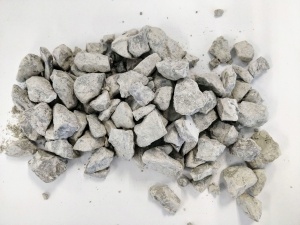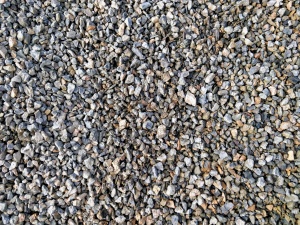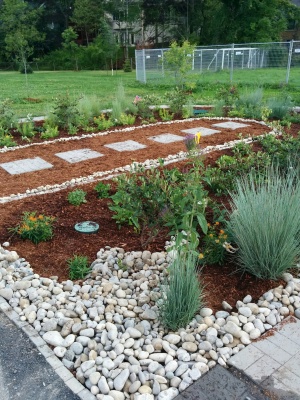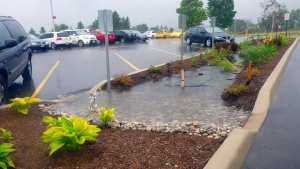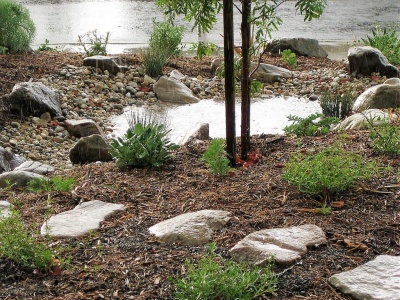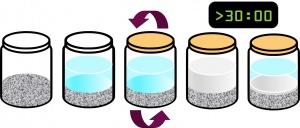Aggregates
This is a collection of three articles with the common theme of being aggregate products for various applications in LID.
Underground construction aggregates[edit]
For reservoirs[edit]
This article gives recommendations for aggregate to be used to store water for infiltration. This is usually called 'clear stone' at aggregate yards.
To see an analysis of Ontario Standard Specifications for granular materials, see OPSS aggregates.
For advice on decorative surface aggregates see Stone
Gravel used for underdrains in bioretention, infiltration trenches and chambers, and exfiltration trenches should be 20 or 50 mm, uniformly-graded, clean (maximum wash loss of 0.5%), crushed angular stone that has a porosity of 0.4[1].
The clean wash to prevent rapid accumulation of fines from the aggregate particles in the base of the reservoir. The uniform grading and the angularity are important to maintain pore throats and clear voids between particles. (i.e. achieve the porosity). Porosity and permeability are directly influenced by the size, gradation and angularity of the particles [2]. See jar test for on-site verification testing protocols.
Gravel with structural requirements should also meet the following criteria:
- Minimum durability index of 35
- Maximum abrasion of 10% for 100 revolutions and maximum of 50% for 500 revolutions
Standard specifications for the gradation of aggregates are maintained by ASTM D2940
The highest porosity is found in uniformly graded aggregate, as there are no smaller particles to occupy the inter-particle pores. [2]
Higher permeability is found in larger, angular, uniformly graded aggregate. This is due to larger pore sizes and lower tortuosity. [2]
For choking/choker layers[edit]
In bioretention systems a choker layer of ≥ 100 mm depth is the recommended method to prevent migration of finer filter media into the underlying storage reservoir aggregate. These same mid-sized granular materials are recommended for use in Stormwater planter underdrains and may be useful in the fine grading of foundations courses for permeable pavements.
Suitable materials include:
- High performance bedding (HPB)
- Clean, angular aggregate screened to between 6 and 10 mm. Widely available and designed specifically for drainage applications. Free from fines by definition.
- HL 6
- Is a clean, angular aggregate screened between 10 and 20 mm. Free from fines by definition.
- Pea Gravel
- Rounded natural aggregate, screened between 5 and 15 mm, and washed free from fines.
In most scenarios, a geotextile layer is unnecessary and has been associated with rapid decline and clogging in some circumstances.
OPS Aggregates[edit]
Of the standard granular materials in the standard OPSS.MUNI 1010 only Granular O is recommended as a substitute for clear stone in LID construction.
Where Granular O is substituted for clear stone in underground reservoir structures, the porosity used in design calculations shall be 0.3 unless laboratory testing proves otherwise.
Examples of BMPs with underground reservoirs include Underdrains, infiltration trenches, permeable pavements, infiltration chambers, exfiltration trenches.
All other mixes must be avoided for free drainage or storage as they are permitted to contain a higher enough proportion of fines to reduce permeability below 50 mm/hr.
For more information see OPS aggregates
Landscaping aggregates[edit]
For advice on aggregates used in underdrains, see Reservoir aggregate.
Stone or gravel can serve as a low maintenance decorative feature, but it may also serve many practical functions on the surface of an LID practice.
Stone for erosion control[edit]
Aggregates used to line swales or otherwise dissipate energy (e.g. in forebays) should have high angularity to increase the permissible shear stress applied by the flow of water. [3] However, in some surface landscaped applications there may be a desire to use a rounded aggregate such as 'river rock' for aesthetic reasons. Rounded stones should be of sufficient size to resist being moved by the flow of water. Typical stone for this purpose ranges between 50 mm and 250 mm in diameter. The larger the stone, the more energy dissipation.
- Stone beds should be twice as thick as the largest stone's diameter.
- If the stone bed is underlain by a drainage geotextile, annual inspection and possible replacement should be performed as there is a potential for clogging of this layer to occur.
Stone lining the ponding zone of this rain garden. Image credit California Native Plant Society
Coarse angular stone laid onto a geogrid and geotextile. Image from wikimedia commons
Stone mulch[edit]
Finer inorganic mulch materials can be of value applied in areas with extended ponding times i.e. in the the centre of recessed, bowl shaped bioretention, stormwater planters, trenches or swale practices. Inorganic mulches resist movement from flowing water and do not float. Applying a thin layer of inorganic mulch over the top of wood based mulch has been shown to reduce migration of the underlying layer by around 25% [4]. Inorganic mulches which may be available locally, include:
- Pea gravel
- River rock/beach stone
- Recycled glass
- Crushed mussel shells
On-site verification[edit]
Specifying that aggregates for the construction of LID practices must be free from fines is important. But checking that the delivered materials meet specification is essential to reduce problems with construction and longer term performance.
When possible, Construction Managers should observe the offloading of materials to watch for dust clouds. Aggregates or sand for LID construction should not give rise to clouds of dust when dumped.
A simple jar test can be used to gauge the proportion of fines in an aggregate product before acceptance.
Apparatus:
- A large wide-mouthed jar - glass or clear plastic are both fine,
- Tap water, and
- The aggregate to be tested.
Method:
- Collect approximately 5 cm of material in the jar (or at least two complete layers of 50 mm clear stone),
- Add water to around 3/4 full,
- Secure cap and shake,
- Leave for at least 30 minutes and until the water is clear - plan to run the test overnight when possible,
- Examine the layer of sediment - if > 3 mm has been washed from 5 cm of product, the material should be rejected,
Note that the sediment may collect on top of, or at the bottom of the construction material.
External references[edit]
- Heger, S. (2014). Critical Aspects During System Installation and Inspection General equipment considerations. In PMSA conference. Retrieved from http://www.psma.net/pdf/14/conference-presentations/Keys_to_Installation_(Heger).pdf
- Manitoba. (2010). Onsite Wastewater Management Systems: Field Reference Guide - JAR TEST. Retrieved from http://www.gov.mb.ca/sd/envprograms/wastewater/pdf/jar_test_reference_03_2010.pdf
- ↑ Porosity of Structural Backfill, Tech Sheet #1, Stormtech, Nov 2012, http://www.stormtech.com/download_files/pdf/techsheet1.pdf accessed 16 October 2017
- ↑ 2.0 2.1 2.2 Judge, Aaron, "Measurement of the Hydraulic Conductivity of Gravels Using a Laboratory Permeameter and Silty Sands Using Field Testing with Observation Wells" (2013). Dissertations. 746. http://scholarworks.umass.edu/open_access_dissertations/746
- ↑ Roger T. Kilgore and George K. Cotton, (2005) Design of Roadside Channels with Flexible Linings Hydraulic Engineering Circular Number 15, Third Edition https://www.fhwa.dot.gov/engineering/hydraulics/pubs/05114/05114.pdf
- ↑ Simcock, R and Dando, J. 2013. Mulch specification for stormwater bioretention devices. Prepared by Landcare Research New Zealand Ltd for Auckland Council. Auckland Council technical report, TR2013/056
